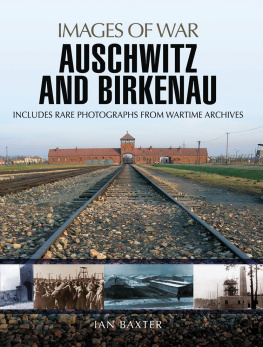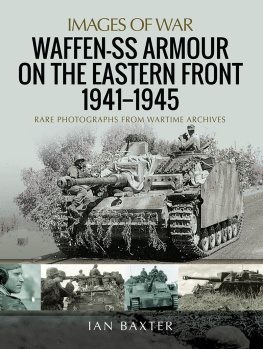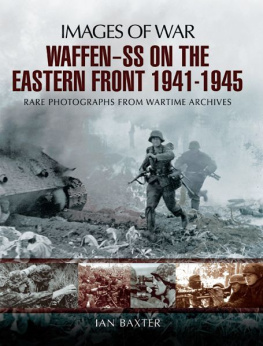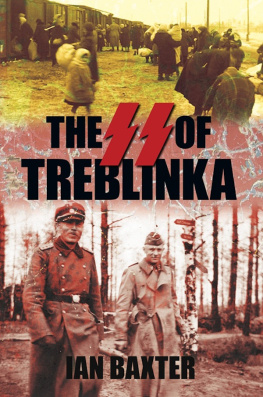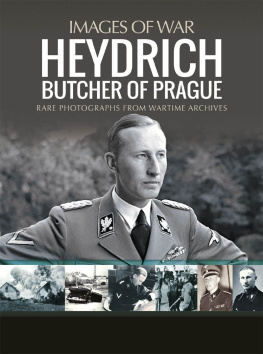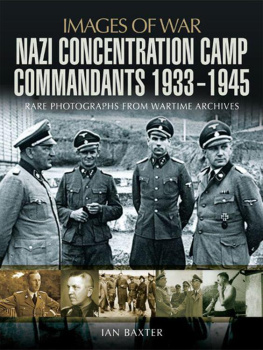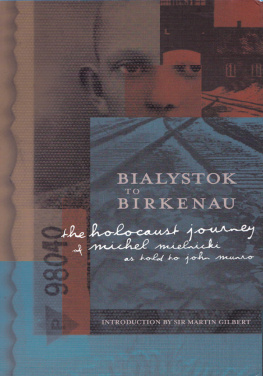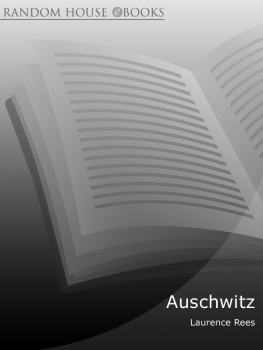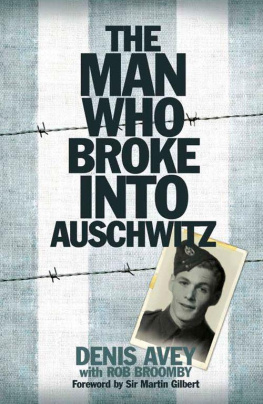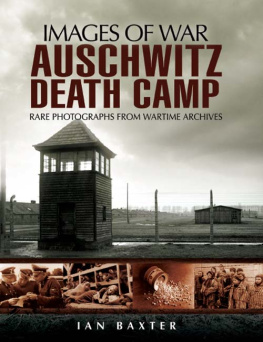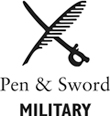
IMAGES OF WAR
AUSCHWITZ AND BIRKENAU
RARE PHOTOGRAPHS FROM WARTIME ARCHIVES
Ian Baxter
First published in Great Britain in 2017 by
PEN & SWORD MILITARY
An imprint of
Pen & Sword Books Ltd
47 Church Street
Barnsley
South Yorkshire
S70 2AS
Copyright Ian Baxter, 2017
ISBN 978-1-47385-687-5
eISBN 978-1-47385-688-2
Mobi ISBN 978-1-47385-689-9
The right of Ian Baxter to be identified as author of this work has been asserted by him in accordance with the Copyright, Designs and Patents Act 1988.
A CIP catalogue record for this book is available from the British Library.
All rights reserved. No part of this book may be reproduced or transmitted in any form or by any means, electronic or mechanical including photocopying, recording or by any information storage and retrieval system, without permission from the Publisher in writing.
Pen & Sword Books Ltd incorporates the imprints of Pen & Sword Archaeology, Atlas, Aviation, Battleground, Discovery, Family History, History, Maritime, Military, Naval, Politics, Railways, Select, Social History, Transport, True Crime, and Claymore Press, Frontline Books, Leo Cooper, Praetorian Press, Remember When, Seaforth Publishing and Wharncliffe.
For a complete list of Pen & Sword titles please contact
PEN & SWORD BOOKS LIMITED
47 Church Street, Barnsley, South Yorkshire S70 2AS, England
E-mail:
Website: www.pen-and-sword.co.uk
About the Author
I an Baxter is a military historian who specialises in German twentieth century military history. He has written more than twenty books including Afrika-Korps; Auschwitz Death Camp; Belsen and its Liberation; Blitzkrieg in the West; The Crushing of Poland; Final Days of the Reich; German Army on the Eastern Front The Advance; German Army on the Eastern Front The Retreat 19431945; German Guns of the Third Reich; Himmlers Nazi Concentration Camp Guards; Hitlers Defeat on the Eastern Front; Hitlers Headquarters 19391945; Hitlers Heavy Panzers 194345; Hitlers Mountain Troops 19391945: The Gebirgsjager; Hitlers Panzers; Nazi Concentration Camp Commandants 19331945; Panzer Divisions at War 19391945; Retreat to Berlin; The U-Boat War 19391945; at Arnhem, Hitlerjugend, Battle of Caen 1944, Gebirgsjger at War, Panzer Crews, Hitlerjugend Guerrillas, Last Battles in the East, The Battle of Berlin , and many more. He has also reviewed numerous military studies for publication, supplied thousands of photographs and important documents to various publishers and film production companies worldwide, and lectures to various schools, colleges and universities throughout the United Kingdom and Ireland.
Introduction
U sing many contemporary rare and unpublished images this book is a photographic insight into Auschwitz-Birkenau today. With over 250 images the book shows in great detail the sheer size and scope of Auschwitz and the nearby Birkenau complex. It reveals how the buildings were constructed and then tells of the private firms that were employed by the SS to build them.
Accompanied with captions and text the book draws on key documents from the German Building Office showing the evolution of Auschwitz concentration camp using plans, letters, telegrams, work site labour reports, and minutes of meetings. It unveils how the SS needed civilian expertise to install heating, electrical, and sewage systems, to build chimneys, and to provide building shells. Many of these buildings are still standing today. It shows just how many civilian companies were involved, professionally cooperation in genocide, and reveals just how eager they were to produce the goods for the SS for financial reward.
The book shows the step-by-step transformation of the buildings including the crematoria and how these buildings aided the largest killing factory of all time. The reader will see for himself the extensive array of buildings comprising of the commandants villa, prisoner reception building, prisoner barracks and huts, the delousing area known as the Sauna, the camp hospital, workshops, the kitchens, the SS administrative buildings, SS barracks, and the areas where the crematoria once stood, now lying in heaps of ruins blown up by the SS in a last minute attempt to conceal their murderous activities before the arrival of the Red Army now a shrine to the many hundreds of thousands that perished there.
The reader will quickly learn how pivotal the Auschwitz-Birkenau complex was, and how it became the Nazi centrepiece for forced labour and genocide. This book is a real addition to holocaust studies and is proof of the horrors that were inflicted on those that passed through the gates of Auschwitz-Birkenau.
* * *
The views or opinions expressed in this book, and the context in which the images are used, do not necessarily reflect the views or policy of, nor imply approval or endorsement by, the United States Holocaust Memorial Museum (USHMM).
Glossary and Abbreviations
Occupied part of eastern Poland not annexed to Germany.
Geheime Staatspolizei: state secret police.
Reich Chief of the SS and German Police.
Reichssicherheitshauptamt: Reich Main Security Office, formed in late 1939, uniting Gestapo, criminal police, SIPO and SD.
SD Sicherheitsdienst: security service of the Nazi Party.
Special unit of SS.
Schutzstaffel: Guard detachment created in 1925 as elite Nazi Party bodyguard that evolved into a security and intelligence service with a military arm.
Weapon SS: Military arm of the SS from 1939 onwards.
Wehrmacht German armed forces.
WVHA Wirtschafts und Verwaltungshauptamt: SS economic and administrative head office responsible for SS economic enterprises and concentration camps from 1942 under the command of Oswald Pohl.
Phase I
Auschwitz I
(Main Camp)
T he German authorities quickly pressed forward to establish various camps in Poland where Polish prisoners could be incarcerated and set to work as stonebreakers and construction workers for buildings and streets. It was envisaged that these Poles would remain as a slave labour force, and it was therefore deemed necessary to erect these so called quarantine camps in order to subdue the local population. Initially, it had been proposed that the quarantine camps were to hold the prisoners until they were sent to the various other concentration camps in the Reich. However, it soon became apparent that this purpose was impracticable so it was approved that these camps were to function as a permanent prison for all those that were unfortunate enough to have been sent there.
On 2 February 940 a former labour exchange and artillery barracks near a small district town in Poland called Owicim had been deemed suitable for the so-called quarantine camps. The site was to be run by SS-Hauptsturmfhrer Rudolf Hss, and he was told that the camp should serve as a regional dumping ground for all Polish political prisoners so all these undesirables could be transferred at a moments notice to camps in the west as slave labourers.
The town of Owicim itself was situated in a remote corner of south-western Poland, in a marshy valley where the Sola River flows into the Vistula about 35 miles west of the ancient city of Krakw.
The location for the camp was a former Polish barracks. The accommodation consisted of eight two-storey and fourteen single-storey brick barracks framing the north and south sides of a large exercise yard which were able to be transformed into a prison camp with extra buildings. The location for the site was also deemed well situated for Auschwitz as it had very good railway connections and was isolated from outside observation. Although the water supply was polluted and there were mosquitoes everywhere, the Germans would be able to transform these swamped and infested marshes along the Vistula and Sola Rivers into what they envisaged as a valuable outpost of the Reich.
Next page
